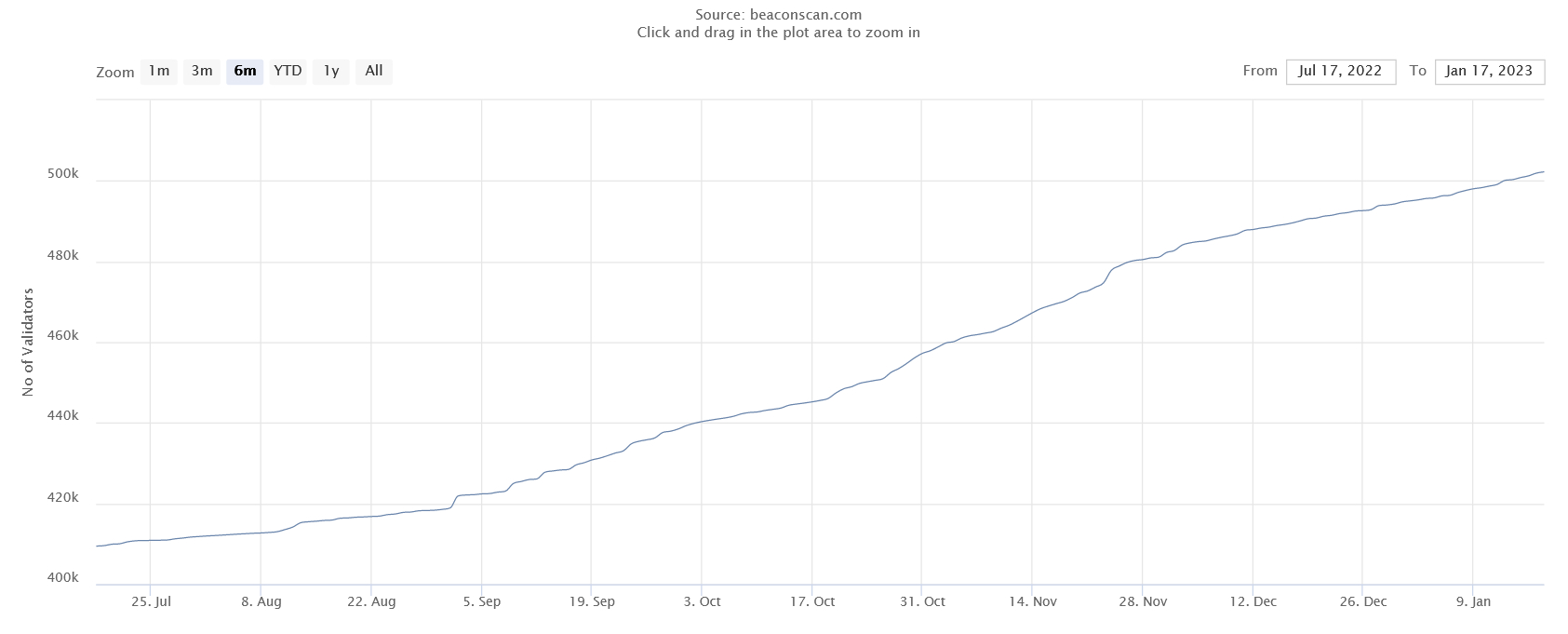Ethereum has reached a new milestone in adoption and security as the number of validators on its network now exceeds 500,000, according to data from BeaconScan. As to whether this milestone or the upcoming Shanghai upgrade will impact Ethereum’s price, this depends on a number of factors that we’ll explore below.
Regardless, this is a significant achievement for the Ethereum ecosystem and highlights the growing hype and confidence in the network as it gears up for the Shanghai upgrade, which will allow withdrawals of staked ether for the first time.
Significance of the 500,000 Validator Milestone
The increasing number of validators indicates that more and more individuals and entities are willing to invest in the network and play a role in maintaining its integrity and security, which is potentially a bullish sign for Ethereum’s price in the wake of the Shanghai upgrade.
“We can consider the security of the Ethereum network on two axes. One is the total value staked. The other is the degree of decentralization,” said Ben Edgington, Ethereum developer and Lead Product Owner of Ethereum at ConsenSys, a company that works on the Ethereum and Quorum blockchains.

Although the decentralization of validators may be difficult to analyze, reports indicate there are about 11,400 physical nodes across 80 countries.
“[This] is a considerable degree of decentralization, and much more distributed than we had under proof-of-work (before the merge),” Edgington said. “Many of these nodes are run by home stakers such as myself, underpinning the protocol with a huge degree of resilience and diversity.”
With the total value staked on the Ethereum network reaching 16 million ETH (over $22 billion), it becomes increasingly difficult and costly to attack the network, including pulling off a 51% attack.
What are Validators and How do they Work?
Validators are essential in maintaining the integrity and security of the Ethereum network. They are responsible for verifying and processing transactions on the blockchain by validating the digital signatures that accompany each transaction.
This ensures that the conditions specified in each transaction’s smart contract code have been met before they are added to the blockchain.
To become a validator, an individual or entity must deposit 32 ETH, which is currently worth around $45,000. This deposit is used to run a dedicated staking node on the proof-of-stake blockchain.
Once the deposit is made, the validator earns staking rewards from the network in exchange for their services. However, the staked funds are locked in the network and cannot be accessed until the Shanghai upgrade, which is expected to happen in March. This upgrade will allow withdrawals of staked ether for the first time.
Validators play a critical role in the Ethereum ecosystem, as they are responsible for maintaining the integrity and security of the network. They act as gatekeepers, ensuring that only valid transactions are added to the blockchain, and that the network remains decentralized and secure. The high deposit requirement to become a validator also ensures that only those who are committed to the network and have a significant financial stake in its success become validators.
Shanghai Upgrade Progress and Details
Ethereum developers say they are making steady progress towards their goal of launching the Shanghai upgrade and enabling staked ETH withdrawals on the network by March. This week, the group launched “devnet 2,” a developer network that is specifically designed to allow client teams to tweak the ETH withdrawal process and ensure that everything is working properly.
According to a developer call earlier in the month, the network launch went mostly smoothly, with minor but expected hiccups.
“Things are looking great. I’m not aware of any issues that could delay Shanghai at this moment,” said Ethereum core developer Marius Van Der Wijden.
The Shanghai upgrade is a highly-anticipated event for the Ethereum community, as the introduction of the ability to withdraw funds is understandably a priority for the Ethereum community and its developers. The Ethereum price should be impacted by the Shanghai upgrade as investors and stakers gain more confidence in the platform.
The Shanghai upgrade was initially intended to include a number of other eagerly-awaited updates as well, including proto-danksharding, a streamlined data-sampling process that would make layer-2 transactions on Ethereum substantially cheaper and faster.
However, proto-danksharding was eventually scrapped from Shanghai to ensure the ETH withdrawal capability is rolled out as quickly as possible.
Developers also made the difficult decision to further delay updates to the Ethereum Virtual Machine (EVM), the mechanism underlying Ethereum that deploys smart contracts. There have been no updates to the EVM in over two years, since such maintenance was delayed in the era of the merge to avoid further complicating an already intricate procedure.
Luckily, these delays may make a March delivery date for Shanghai more likely.
“We want to make sure that everything is working as it should before we release the Shanghai upgrade, and these delays will help us do that,” explained Van Der Wijden.
Shanghai Upgrade Bullish for Ethereum Price?
Whether or not the Shanghai upgrade is bullish for Ethereum’s price depends largely on macroeconomic factors and the wider market cycle, at this point. And of course, whether the upgrade goes smoothly.
The lead up to the upgrade could see a raise in Ethereum’s price, while the aftermath could see traders taking profits and bringing the price down temporarily.
However, if everything goes as planned and the Ethereum ecosystem continues to progress and pass the major milestone, ultimately the long-term outlook for the major crypto, including its price action, should be positive.
Credit: Source link












































































































































